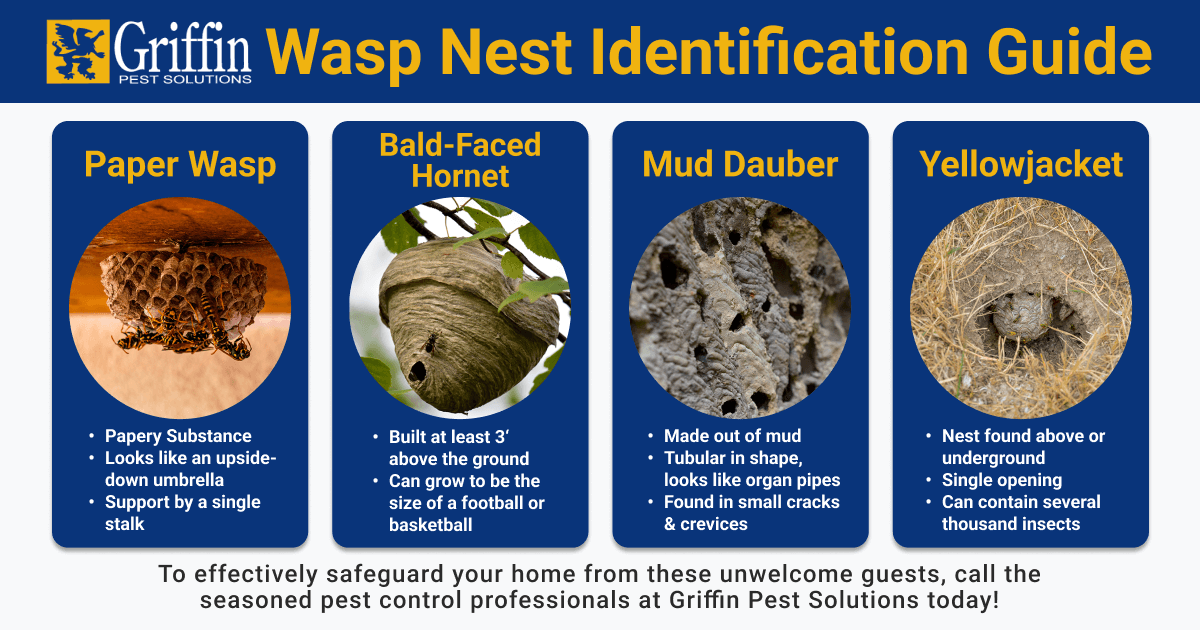
Bees and other stinging insects play a crucial role in the environment, both as natural pest control and as some of our most important pollinators. While these insects need to have nests out in the wild, they certainly aren’t something you want to find near your home or business. Especially if you come across an aggressive species, you’ll want to be cautious and call for professional bee, wasp, or hornet nest removal service.
While you’re waiting for an expert to arrive at your property and carefully remove the stinging insects, here are some things you should know about nests and hives—and how you can avoid painful encounters with them.
What Do Bee, Wasp, and Hornet Nests Look Like?
Though bees, wasps, and hornets share a lot of habits, their nests are often a bit different. And, since wasps and hornets tend to be a lot more dangerous than bees, it’s helpful to know what type of pest is settling into your property. Here’s what each nest looks like:
- Bees: Bees are opportunistic nesters, which means they usually look for an already-sheltered place to settle down. This could be tree hollows, wall voids, abandoned bird nests, or holes in the soil. Most bee nests are hidden from view, but the heightened bee activity around the area is a telltale sign that they’re living nearby.
- Wasps: Most wasps build their nests using a mixture of chewed-up wood, mud, and saliva. In the end, they look like a grayish papier-mache football. That said, some species such as mud daubers build slightly different nests. These wasps use mud to create tiny rows of small tubes, which are meant to house just one or two insects at a time.
- Hornets: Hornets are like a bigger version of wasps, so their nests look very similar. In addition to the grayish paper-like material, though, hornets usually build a protective layer on the outside of their nest. Their nests are also typically larger and have just one single opening.

Need Bee, Wasp & Hornet Pest Control Services?
Bee Nests Versus Beehives
Nests and hives may seem like two different words for the same thing, but they’re actually entirely different things. Beehives refer to structures constructed specifically for honey bees to live and produce honey inside of. Honey bees can make them by themselves, or people can build them to foster bees. Only Apis-genus honeybees construct beehives in the true sense, by secreting beeswax and shaping it into combs. True beehives constructed out of beeswax are relatively rare in the wild.
Nests are far more common, and house all other kinds of bees and wasps. They’re made of materials like paper, processed wood, and other debris and stuck together with resin and saliva. Bees and wasps either build nests into natural cover or hang them in high, inaccessible places. Nests come in a wide variety of shapes and sizes, but most are round and look wooden or paper-based.
Are Beehives Dangerous?
If the beehive is active, then yes, it can be dangerous. Honey bees typically only sting if they feel threatened, and they are only capable of stinging once, so they’re not considered as dangerous as wasps or hornets—but, that doesn’t mean they’re safe to approach. These insects can still cause a lot of pain, especially if they cluster around a target or trigger potentially fatal allergic reactions.
When Do Bees and Wasps Build Nests?
Most stinging insects build their nests in late spring or early summer. This immediately follows the swarming period, where they locate mates and find good places to build for their hives or nests.
Swarming happens in late spring because it’s the first time bees have the resources required to make it happen. To prepare for swarming, the population of a hive increases rapidly, and this population explosion continues until the colony is so full that it needs to split and migrate to new nesting sites.
What to Do If You Have a Bee, Wasp, or Hornet Nest
If you see a wasp or hornet nest, it’s important to avoid it entirely. Even if the nest appears empty, there could still be lingering stinging insects inside. Some species are more aggressive than others, and it’s hard to know when or why they’ll swarm or sting.
When their nests are in high-traffic areas, bees and wasps could be easily threatened and driven to defend their nest at all costs. Nests can be even more dangerous in the late summer and fall months, as the insects begin to die out before the winter months.
Can I Remove a Nest On My Own?
Removing a wasp nest on your own is not recommended. As mentioned previously, nests are likely to contain more stinging insects than you think, which can be very dangerous. As a general rule of thumb, it’s best to enlist the help of a wasp exterminator whenever you’re dealing with stinging insects. Attempting a removal without the right tools could put you at risk of being in a very painful or harmful situation.
Wasp Removal Services in Michigan
Bees, wasps, and hornets are completely normal in the Michigan area. However, their nests can be dangerous when built near residential or commercial properties. At Griffin Pest Solutions, we understand how important it is to safely remove bees and wasps as quickly as possible, which is why we offer fast response times no matter how big or small your infestation is.
If you need to remove a wasp or bee nest quickly and safely, contact us today for help!
Back to Bee, Wasp, & Hornet Exterminators – Control – Removal
